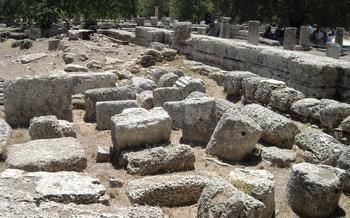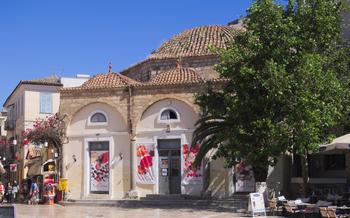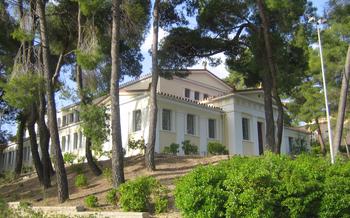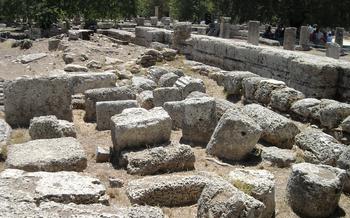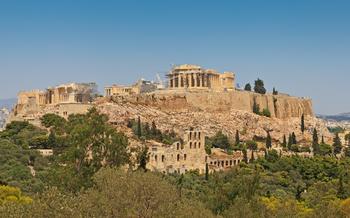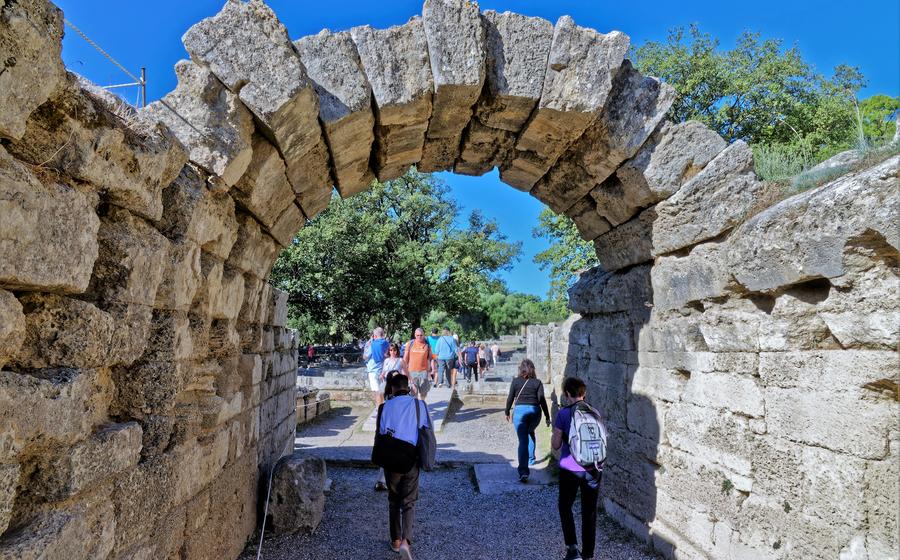
Temple of Athena Alea at Tegea
- The Temple of Athena Alea at Tegea: A Historical Overview
- Location and Accessibility
- Architectural Highlights
- The Cult of Athena Alea
- The Sculpture of Athena Alea
- Archaeological Significance
- Visiting the Temple Today
- Nearby Attractions
- Festivals and Events
- Local Cuisine and Dining
- Accommodation Options
- Shopping and Souvenirs
- Planning Your Visit
- Travel Tips and Practical Information
- Insider Tip: Hidden Gems and Off-the-Beaten-Path Experiences
The Temple of Athena Alea at Tegea: A Historical Overview
The Temple of Athena Alea at Tegea stands as a testament to the architectural prowess and religious devotion of ancient Greece. Erected in the 4th century BCE, the temple was dedicated to Athena Alea, the patron goddess of the city of Tegea. Its construction, attributed to the renowned architect Scopas, marked a significant chapter in Greek history, reflecting the city's growing prominence and wealth.
The temple's design showcased a harmonious blend of Doric and Ionic styles, resulting in a unique architectural masterpiece. The exterior, adorned with majestic columns and intricate sculptures, exuded an aura of grandeur. Inside, the cella housed the colossal statue of Athena Alea, crafted from ivory and gold, a breathtaking representation of the goddess that inspired awe and devotion among the faithful.
Beyond its architectural splendor, the Temple of Athena Alea held immense religious significance. It served as a central location for worshipping Athena, a goddess revered for her wisdom, warfare prowess, and protection. Devotees from across the region flocked to the temple to offer sacrifices, pray for guidance, and seek the goddess's favor.
Archaeological excavations conducted at the site have unearthed a wealth of artifacts, including inscriptions, sculptures, and votive offerings, shedding light on the temple's rich history and religious practices. These discoveries have contributed significantly to our understanding of ancient Greek religion, art, and architecture.
Location and Accessibility
The Temple of Athena Alea stands majestically in the heart of the ancient city of Tegea, located in the Peloponnese region of southern Greece. This picturesque village, nestled amidst rolling hills and olive groves, is steeped in history and offers a serene setting to explore this architectural marvel.
To reach Tegea, visitors can opt for various transportation options. The nearest major city, Tripoli, is approximately 15 kilometers away and provides convenient access via regular bus services. Alternatively, renting a car offers greater flexibility to explore the region at your own pace.
Once in Tegea, the temple is easily accessible on foot from the village center. Its prominent location atop a hill ensures that it is visible from afar, guiding visitors towards this ancient sanctuary. The well-preserved ruins are surrounded by a tranquil countryside, inviting you to immerse yourself in the tranquility of this sacred site.
Architectural Highlights
In terms of design, the Temple of Athena Alea at Tegea is a marvel of Doric architecture. Its peripteral arrangement features 6 columns on the short sides and 15 on the long sides, creating a majestic colonnade surrounding the temple's cella. The columns stand over 6 meters tall, exuding an aura of grandeur.
The pediments of the temple are adorned with intricate sculptural compositions depicting scenes from Greek mythology. The eastern pediment showcases the Calydonian Boar Hunt, while the western pediment portrays the Battle of the Lapiths and Centaurs. These sculptures, masterfully crafted from Parian marble, showcase the exceptional skill and artistry of ancient Greek sculptors.
Inside the temple, the cella houses the cult statue of Athena Alea, a colossal figure that once stood over 8 meters tall. The statue, made of ivory and gold, was considered one of the most magnificent representations of the goddess in the ancient world. Unfortunately, it did not survive the passage of time, and only fragments remain today.
The Temple of Athena Alea stands as a testament to the architectural prowess of the ancient Greeks. Its elegant proportions, intricate sculptures, and grand scale make it a must-see for anyone interested in ancient architecture and Greek history.
The Cult of Athena Alea
Goddess Athena's Association with Tegea
The ancient city of Tegea held a special significance in the worship of the goddess Athena, one of the most revered deities in Greek mythology. Athena, the goddess of wisdom, war, and crafts, was deeply connected to Tegea and played a central role in the city's religious and cultural identity.
Significance of the Temple in Her Worship
The Temple of Athena Alea served as the primary sanctuary for the goddess in Tegea. It was here that the local population honored and paid homage to Athena, seeking her protection and guidance. The temple was not merely a place of worship but also a symbol of the city's devotion and allegiance to the goddess.
Rituals and Ceremonies Held at the Temple
The temple was the focal point for various religious ceremonies and rituals dedicated to Athena. The most prominent of these was the annual festival known as the Aleaia, held in honor of the goddess. During the Aleaia, grand processions, sacrifices, and athletic competitions took place, attracting pilgrims and visitors from across the Peloponnese.
Myths and Legends Related to Athena Alea
Tegea was closely intertwined with the myths and legends surrounding Athena. One of the most famous tales tells of how Athena came to be associated with the city. According to the myth, the goddess engaged in a friendly contest with the god Poseidon, each offering a gift to the city. Athena bestowed the gift of an olive tree, while Poseidon offered a horse. The locals chose Athena's gift, and in gratitude, Athena became their patron goddess.
The Sculpture of Athena Alea
The most famous and iconic artifact associated with the Temple of Athena Alea is the colossal statue of Athena herself, which once stood within the temple's cella. Created by the renowned sculptor Endoios in the 4th century BC, this masterpiece of ancient Greek art was crafted from ivory and gold, materials that were highly prized and symbolized the goddess's divinity and power.
The statue depicted Athena in a majestic and imposing manner, standing tall and radiating an aura of authority. Her face was serene and beautiful, with delicate features and a gentle smile that hinted at her benevolent nature. The goddess wore a long, flowing peplos that clung gracefully to her body, revealing her graceful form and athletic physique.
On her head, Athena wore a magnificent helmet, adorned with intricate designs and a towering crest. In her right hand, she held a Nike, the goddess of victory, symbolizing her triumph over her enemies. In her left hand, she grasped a spear, representing her role as a protector and warrior goddess.
The statue of Athena Alea was not merely a work of art but also a powerful symbol of the goddess's presence and influence in Tegea. It was revered and worshipped by the people of the city, who believed that it embodied the divine power and protection of Athena. Today, the statue no longer exists, but its legacy lives on through the numerous replicas and representations that have been created over the centuries, ensuring that the beauty and majesty of this iconic masterpiece continue to inspire and awe.
Archaeological Significance
The Temple of Athena Alea at Tegea holds immense archaeological significance, serving as a valuable source of knowledge about ancient Greek architecture and religious practices. Excavations at the site have yielded a wealth of artifacts and inscriptions, including fragments of sculptures, pottery, and inscriptions. These discoveries have provided insights into the construction techniques, artistic styles, and religious rituals associated with the temple.
The temple's well-preserved remains offer a glimpse into the architectural prowess of the ancient Greeks. The unique features of its design, such as the use of Corinthian columns and the intricate sculptures that adorned its pediments, have made it a subject of study for archaeologists and architectural historians.
Moreover, the temple's association with the goddess Athena Alea has shed light on the religious beliefs and practices of the ancient Greeks. Inscriptions found at the site have revealed the names of priests and priestesses who served in the temple, as well as details about the rituals and ceremonies that were performed. These inscriptions have also provided valuable information about the myths and legends associated with Athena Alea, offering a deeper understanding of Greek mythology and its role in shaping ancient Greek society.
Ongoing research and excavations at the Temple of Athena Alea continue to contribute to our knowledge of ancient Greek architecture, religion, and culture. New discoveries are constantly being made, providing valuable insights into the lives and beliefs of the people who inhabited this region centuries ago.
Visiting the Temple Today
The Temple of Athena Alea stands as a testament to the enduring legacy of ancient Greek architecture. While the ravages of time have taken their toll, the temple's grandeur and significance remain palpable. Visitors to Tegea can explore the temple's well-preserved ruins and appreciate the intricate details that have survived the centuries.
Restoration efforts have been undertaken to preserve the temple's structural integrity and protect its remaining features. These efforts have focused on stabilizing the temple's foundations, repairing damaged columns, and reconstructing portions of the entablature. As a result, visitors can safely walk among the temple's ruins and marvel at its architectural finesse.
The temple is open to the public, and visitors can explore the site at their own pace. Guided tours are also available for those who wish to learn more about the temple's history, significance, and unique features. These tours provide insights into the temple's construction, religious practices, and the myths and legends surrounding Athena Alea.
Whether you choose to explore the temple independently or with a guide, be sure to take your time to capture the temple's beauty from various angles. The temple's imposing columns, intricate sculptures, and serene surroundings offer countless photo opportunities. Remember to bring your camera and tripod to capture the temple's majesty in all its glory.
Nearby Attractions
In addition to the Temple of Athena Alea, the region of Tegea boasts a wealth of other ancient sites and historical landmarks, as well as natural wonders and scenic spots to explore.
Just a short drive away, you can visit the ancient city of Sparta, home to the legendary warrior society that once dominated the Peloponnese. Here, you can explore the ruins of the ancient acropolis, the theater, and the temple of Artemis Orthia.
Another must-see destination is the picturesque village of Monemvasia, built on a rocky peninsula and surrounded by crystal-clear waters. Wander through its narrow cobbled streets, admire the medieval architecture, and soak in the breathtaking views of the Aegean Sea.
If you're a nature enthusiast, don't miss the opportunity to explore the Parnonas Mountain range, which offers stunning hiking trails, lush forests, and panoramic vistas. The region is also home to several beautiful beaches, such as Kalogria and Glyfa, where you can relax and enjoy the sun and sea.
For those interested in culture and history, there are several museums and cultural institutions in the region. The Archaeological Museum of Tegea houses an impressive collection of artifacts and sculptures from the ancient city, providing a glimpse into its rich past. The Museum of Olive and Oil in Sparta offers a fascinating insight into the history and cultural significance of olive oil production in the region.
To make the most of your time in Tegea, consider combining your visit to the Temple of Athena Alea with other nearby attractions. Plan a day trip to Sparta or Monemvasia, or embark on a hiking adventure in the Parnonas Mountains. The region offers a diverse range of experiences that will appeal to history buffs, nature lovers, and culture enthusiasts alike.
Festivals and Events
Tegea comes alive with various festivals and events throughout the year, offering travelers a chance to immerse themselves in the region's rich culture and traditions. One of the most prominent celebrations is the Tegean Festival, held annually in honor of Athena Alea. This lively festival features traditional music, dancing, and reenactments of ancient rituals. Visitors can witness processions, theatrical performances, and religious ceremonies that bring the temple's history to life.
For those interested in experiencing a taste of authentic Greek customs, the Tegean Gastronomic Festival showcases the region's culinary delights. Held during the summer months, this festival features cooking demonstrations, food tastings, and opportunities to sample local specialties. Visitors can savor traditional dishes, learn about regional ingredients, and interact with local chefs and producers.
To delve deeper into the temple's significance, the Tegean Archaeological Festival offers guided tours, lectures, and workshops led by experts in ancient Greek history and archaeology. This festival provides an in-depth exploration of the temple's architecture, artifacts, and religious practices. Participants can engage in discussions, hands-on activities, and behind-the-scenes tours, gaining a comprehensive understanding of the temple's role in ancient Greek society.
Whether you seek vibrant celebrations, culinary adventures, or educational experiences, Tegea's festivals and events offer unique opportunities to connect with the temple's legacy and the vibrant culture of the region. Embrace the festive spirit, mingle with locals, and create lasting memories as you explore the rich tapestry of Tegea's traditions.
Local Cuisine and Dining
Tegea offers a delightful culinary experience with traditional Greek dishes and local specialties. To fully immerse yourself in the authentic flavors of the region, be sure to indulge in the delicious home-cooked meals prepared in local tavernas and restaurants. Try the slow-roasted lamb with lemon potatoes, a local favorite known for its tender meat and crispy skin. Freshly caught seafood is another must-try, as Tegea is close to the coast. Grilled octopus, calamari, and sea bass are popular choices.
For vegetarians and vegans, there are plenty of options to satisfy your taste buds. Traditional Greek cuisine features an array of vegetable dishes, such as stuffed tomatoes and peppers, moussaka, and gemista (stuffed vegetables). Don't miss the opportunity to sample the local olives, which are renowned for their unique flavor and quality.
To enhance your culinary journey, venture into the local markets and shops to discover handmade crafts and souvenirs inspired by the temple and ancient Greek history. You'll find everything from pottery and jewelry to olive oil and honey, all produced locally. Bargaining is expected, so don't be afraid to negotiate for the best price while supporting local artisans and businesses.
Accommodation Options
When planning a visit to the Temple of Athena Alea at Tegea, finding suitable accommodation is essential to ensure a comfortable and convenient stay.
- There are several hotels and guesthouses in Tegea and nearby towns, offering a range of options to suit different budgets and preferences.
- Some accommodations are located within walking distance of the temple, while others may require a short drive or public transportation.
- Consider factors such as proximity to the temple, amenities, and guest reviews when choosing your accommodation.
For a more immersive experience, consider staying in a traditional Greek guesthouse or bed and breakfast.
- These accommodations often offer a more authentic atmosphere and the opportunity to interact with local hosts.
- Many guesthouses also serve delicious homemade breakfasts featuring local specialties, allowing you to start your day with a taste of Greek cuisine.
- Be sure to book your accommodation in advance, especially during peak tourist season, to avoid any last-minute surprises.
Shopping and Souvenirs
After exploring the ancient ruins and immersing yourself in history, you may want to take home a piece of Tegea with you. There are several local shops and markets where you can find unique souvenirs and handmade crafts. Look for items inspired by the Temple of Athena Alea or ancient Greek history, such as pottery, jewelry, sculptures, and replicas of artifacts. Bargaining is acceptable, and it's a great way to get a good deal and support local artisans. If you're looking for something truly special, consider purchasing a handmade item as a lasting memento of your visit. These one-of-a-kind creations are often made with traditional techniques and materials, giving you a tangible connection to the region's rich cultural heritage.
Planning Your Visit
When planning your visit to the Temple of Athena Alea at Tegea, consider the best time of year to optimize your experience. The shoulder seasons (spring and autumn) offer pleasant weather and fewer crowds, allowing you to explore at a more relaxed pace. Summer months can be hot and crowded, but they also offer longer daylight hours for photography and sightseeing.
To make the most of your time, consider a day trip from Athens or a longer stay in Tegea or nearby towns. With a day trip, you can combine a visit to the temple with other attractions in the Peloponnese, such as the ancient city of Mycenae or the seaside town of Nafplio. If you have more time, consider staying overnight in Tegea to delve deeper into the region's history and culture.
Create a personalized itinerary based on your interests and time constraints. For a comprehensive experience, include a guided tour of the temple to learn about its history, architecture, and significance. You can also opt for self-guided exploration, using guidebooks or mobile apps to navigate the site at your own pace.
Remember to bring comfortable shoes for walking on uneven surfaces, as well as sunscreen, a hat, and water, especially during the summer months. Capture the temple's grandeur with your camera, but be respectful of other visitors and any restrictions on photography.
Travel Tips and Practical Information
When visiting the Temple of Athena Alea at Tegea, it's essential to consider practicalities to ensure a smooth and enjoyable experience. Firstly, familiarize yourself with the local currency, the Euro, and carry a mix of cash and cards for transactions. Respect local customs by dressing modestly and behaving respectfully at religious sites. For safety, remain vigilant, avoid isolated areas at night, and keep valuables secure.
To enhance your visit, download mobile apps like Google Maps for navigation and "Visit Peloponnese" for detailed information on attractions and events. Check official websites for up-to-date information on opening hours, admission fees, and any special events. Consider purchasing a Peloponnese Pass for discounted entry to multiple sites, including the Temple of Athena Alea. Remember to pack comfortable shoes for walking on uneven terrain and bring water, especially during hot weather.
Insider Tip: Hidden Gems and Off-the-Beaten-Path Experiences
Beyond the main attractions, Tegea and the surrounding area offer many hidden gems and off-the-beaten-path experiences for those willing to explore. Visit the picturesque village of Vamvakou, known for its traditional architecture and stunning views of the surrounding mountains. Embark on a hike through the scenic Lykaionas Gorge, where you can encounter diverse flora and fauna. Discover the ancient theater of Megalopolis, an impressive reminder of the region's rich history. For a unique perspective, take a hot air balloon ride over the Arcadian countryside, offering breathtaking aerial views of the temple and the surrounding landscape. Don't miss the opportunity to visit the local wineries and sample the region's renowned wines, known for their distinct flavors and aromas. Whether you seek tranquility in nature, cultural immersion, or culinary delights, Tegea holds many secrets waiting to be uncovered.

